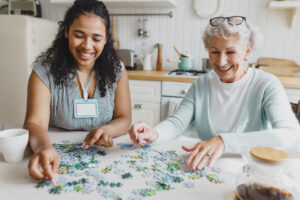Tucker is 6, and William is 76. Tucker loves to go next door to spend time with his neighbor. At first, it was because William would always let him have three Twizzlers, but over time Tucker’s visits were planned because of the fun he had. Both friends had something to teach the other—and plenty to learn from the perspective at the opposite end of the century.
Multigenerational households are becoming more common. But it’s also true that long distance relationships between grandparents and grandkids are a familiar story for some. Unfortunately, it is also common for older adults to be isolated, without significant family and community connections. In all cases, intergenerational activities can bring inspiring benefits to seniors, as well as to kids.
The Benefits of Intergenerational Programs and Activities for Seniors and Youth
When the older adults and the youth in our community get together, they are able to share very different and equally valuable perspectives. Kids come with abundant and original energy. They are seeing and experiencing many things for the first time. Aging adults, on the other hand, bring decades of experience and memories from many phases of life. It can be more challenging for seniors to generate energy, so being inspired by children’s generous spark can be uniquely rejuvenating. The task of children and older adults finding a way to meet each other to find a shared pace and a mutual interest brings rewards for those involved and for the larger community.
What other benefits come from intergenerational programs and activities?
- Socialization: These companion interactions offer powerful social experiences for youth and seniors alike. Children learn how to relate to a distant generation that is rapidly growing. And older adults get a surge of energetic interaction—combatting potential isolation.
- Purpose: Older adults often must go through role reversals and changes to the ways they are used to being independent. Spending time with children and sharing their wisdom reignites a sense of purpose. Children, too, can feel the rewards of a greater connection with their elders and the importance of their part in the equation.
- Health: Older adults are likely to get more exercise—for the body, mind, and emotions—when they spend time with kids. This experience can have a positive impact on their overall health. And kids may even develop a greater interest in contributing to the cause of geriatric health in the future.
- Relationships to technology: Because today’s kids are raised with technology as an integral part of daily life, they can be great teachers for older adults who are still trying to get used to the idea and how tech tools work. In the reverse, aging adults can offer important insight for youth about how resourcefulness and fun don’t have to rely on screens and devices.
Of course, regular intergenerational connections help to strengthen our community ties at large. Integration, rather than separation, helps to make the most of our resources, so people of all ages can thrive.
Activity Ideas for Intergenerational Fun
We’ve pulled together some examples of intergenerational activities to get you started, but the possibilities are as wide as your imagination can reach.
Storytelling
Practice speaking and listening with these different ways of telling stories:
- One of you, start telling a story and give one sentence of it. Then, the other person gives the next sentence. Alternate again with each new line and action in the story, riding the waves and surprises that come with collaboration.
- Pull out some old pictures so you can describe the people and events you see in them. Let your younger companion ask questions about those memories and about how things were different back when the pictures were taken.
- Start building a new photo album together. Take photos together that you can print out and include. You can also clip images from magazines and newspapers or draw pictures to scrapbook into your shared album.
Decluttering
Any time is a good time to declutter and simplify your belongings, and it’s never too early for a child to learn about attachment, letting go, and taking responsibility for their stuff. Your unique perspectives can combine for a new and insightful approach to this universal challenge.
It might be a good idea to approach the older adult’s belongings first—and perhaps just a closet or a pile of stuff. You can have a conversation as you go through each item and decide whether it’s for keeps, for trash, or for giveaway. Let the child understand your reasoning—personal, logistical, and charitable—for making decisions about all the items in the pile. And invite them to ask questions that can help them try to relate to your experience.
Then, let it be the younger partner’s turn to go through their toys or books or clothes and decide what they still really need and what might be better off with another child who does need it. Take the time again to discuss why something should stay or go, but keep in mind that if you linger too long, kids can likely find ways to re-attach to things they’d agreed to let go of, so keep the process moving with the focus on creating space for newness and being generous with what might serve another.
Yoga
As an adaptable and personal practice, yoga can be a great way for seniors and youth to come together, move, and be creative. Yoga can be done on the floor, standing, or even in a chair, and partners can assume their poses from different positions and vantage points, depending on what’s comfortable.
Most yoga poses are modeled after features in nature, such as animals and plants. And kids love to use their imaginations to mimic things. If you decide to assume the shape of a snake or an elephant or a hammerhead shark, it’s something both of you can do whether you’re standing, down on the floor or in a chair. Don’t worry so much about the authenticity of your poses; just move in ways that are comfortable and fun. You might even start this activity by filling a bowl or a hat with scraps of paper that give different animals, plants, and other things you want to pretend to be.
If you want to try out a more structured yoga practice that is still simple and adaptable, here’s a series of chair yoga poses that you can do together to loosen up and generate some fun energy.
Generate Your Own Activity Ideas for Seniors and Youth
It’s also a great idea to follow your own interests to develop creative intergenerational ideas. Find ways that your interests and your young companion’s interests intersect. But don’t ignore the ways in which your interests are quite different because those are also very powerful learning opportunities for both of you to expand your horizons and ways of seeing the world.
For more great activity ideas that promote connection and lifelong learning, check out Institute on Aging’s blog. Institute on Aging offers programs for socialization, comprehensive healthcare, independent living services, and much more for aging adults and their caregivers.
Get in touch with us to find out more.







